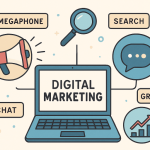In the digital age, where attention spans are shrinking and content competition is fierce, publishers are under more pressure than ever to create online experiences that are not only informative but also easy to consume. Traditional PDFs and static brochures are becoming relics of the past. Readers expect interactivity, speed, and intuitive navigation, and this is precisely where digital catalogs shine.
Digital catalogs aren’t just a modern way to showcase products or content. They fundamentally change how users interact with online publications. By improving readability and boosting engagement, digital catalogs have become essential tools for businesses, brands, and publishers who want to connect with their audiences more effectively.
From Static to Dynamic: A Shift in User Expectations
The average internet user no longer tolerates clunky layouts, hard-to-navigate PDFs, or slow-loading pages. Instead, they’re looking for immersive, smooth, and interactive experiences. Digital catalogs transform static content into something that feels alive. Pages flip like a real magazine, visuals pop with motion, and hyperlinks, videos, and product tags make the reading experience feel effortless.
This dynamic format plays directly into modern reading habits. People now skim more than they read. They’re looking for visual clues, intuitive structure, and easily digestible content. With a digital catalog, you can guide their journey highlight products, emphasize stories, and integrate rich media to keep them engaged without overwhelming them.
Clean Design Enhances Readability
One of the standout features of a well-designed digital catalog is how it enhances readability. Good typography, ample white space, and responsive layouts ensure that text isn’t just legible, it’s inviting. Readers are more likely to stay on the page and absorb information when the visual hierarchy is clear and the layout adapts to their device.
Unlike traditional formats, digital catalogs are built with flexibility in mind. Whether your audience is using a desktop, tablet, or smartphone, the content adjusts automatically. There’s no pinching or zooming required just a seamless reading experience.
Moreover, many platforms offer design templates that prioritize readability. These templates follow best practices in user interface (UI) and user experience (UX) design, so even non-designers can create catalogs that feel polished and professional.
Storytelling Becomes Central to Engagement
A key advantage of digital catalogs is their ability to support storytelling. By combining visuals, text, and interactivity, brands can go beyond simply listing products they can tell a story that connects emotionally with the reader.
This matters because engagement isn’t just about clicks and time on page, it’s about resonance. When readers feel something, they’re more likely to remember your brand and take action. Digital catalogs allow you to create narratives around collections, introduce new campaigns, or guide readers through seasonal trends, all while embedding your brand personality into the publication.
For example, instead of just showing a photo of a summer dress, a brand can tell the story of a beachside getaway, linking to the entire outfit, integrating video of the fabric in motion, and suggesting complementary items all within the same interactive spread.
Easy Navigation Means Longer Sessions
If a user can’t find what they’re looking for, they’ll leave. Fast.
Navigation is one of the most underestimated aspects of user engagement. Digital catalogs tackle this challenge head-on by offering intuitive tools like clickable tables of contents, searchable keywords, and thumbnail previews.
Users can jump to a section that interests them, bookmark pages for later, or share specific spreads with friends. This type of interactivity fosters a sense of control, which makes users more comfortable spending time with your content.
In traditional print, flipping through a 100-page catalog might be a chore. Online, with smart navigation and seamless transitions, it becomes effortless. This fluidity contributes directly to higher engagement metrics and better conversion outcomes.
Bridging Discovery and Action with Interactivity
At the core of improved engagement is interactivity. In a digital catalog, every element can be clickable images can lead to product pages, text can trigger popups with more info, and embedded forms can collect leads without sending users away.
This tight integration between content and conversion points is one of the most powerful aspects of digital catalogs. Users don’t just read; they interact, explore, and buy all from within the same publication.
By embedding shopping links, call-to-actions, and forms inside your digital content, you turn a passive browsing experience into an active one. This transition from “reader” to “participant” makes all the difference in modern marketing strategies.
That’s why more businesses are turning to platforms that specialize in delivering this kind of immersive experience through an online catalog. Not only does it make the content more attractive, but it also aligns with the behavioral patterns of today’s digital consumers.
Real-Time Updates and Analytics Fuel Optimization
Another overlooked advantage of digital catalogs is that they’re never truly finished. Unlike print, where every mistake is permanent and every update requires a new edition, digital catalogs can be updated in real time. Prices can change, product availability can be reflected instantly, and seasonal promotions can go live without reprinting costs or delays.
Even more valuable is the data. With built-in analytics, publishers can see which pages perform best, where users drop off, which links get clicked, and what devices people use. This level of insight is crucial for improving future editions and tailoring content to match audience behavior.
Are users ignoring your opening spread? Maybe the visuals aren’t compelling enough. Are readers abandoning the catalog halfway through? Perhaps your structure needs refinement. This feedback loop helps brands iterate quickly and deliver better content every time.
Final Thoughts: Experience Matters More Than Ever
Digital catalogs are more than just a prettier way to publish brochures they represent a fundamental shift in how we present and consume information online.
By improving readability with clean design, encouraging exploration through interactivity, and enabling seamless navigation, they create experiences that users actually enjoy. And when users enjoy the experience, they stay longer, engage more deeply, and are more likely to take action.
Whether you’re a retailer trying to boost product visibility or a publisher delivering high-value editorial content, embracing digital catalogs isn’t just a smart move, it’s essential for staying relevant in today’s fast-moving digital landscape.
As we continue moving toward a more user-centered internet, the tools we use to share content must evolve. Digital catalogs, with their focus on engagement, accessibility, and design, are leading that evolution.
Lynn Martelli is an editor at Readability. She received her MFA in Creative Writing from Antioch University and has worked as an editor for over 10 years. Lynn has edited a wide variety of books, including fiction, non-fiction, memoirs, and more. In her free time, Lynn enjoys reading, writing, and spending time with her family and friends.















